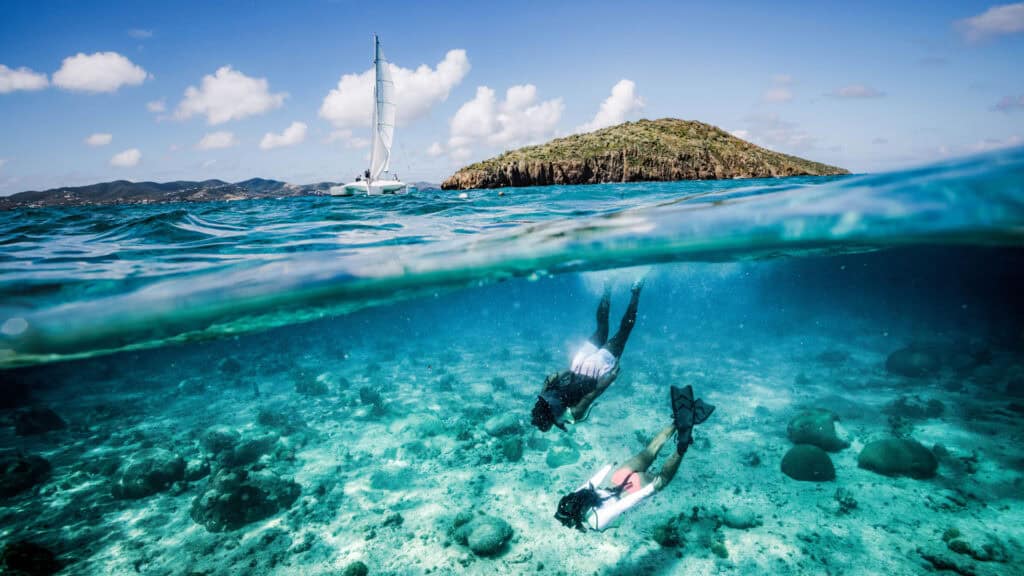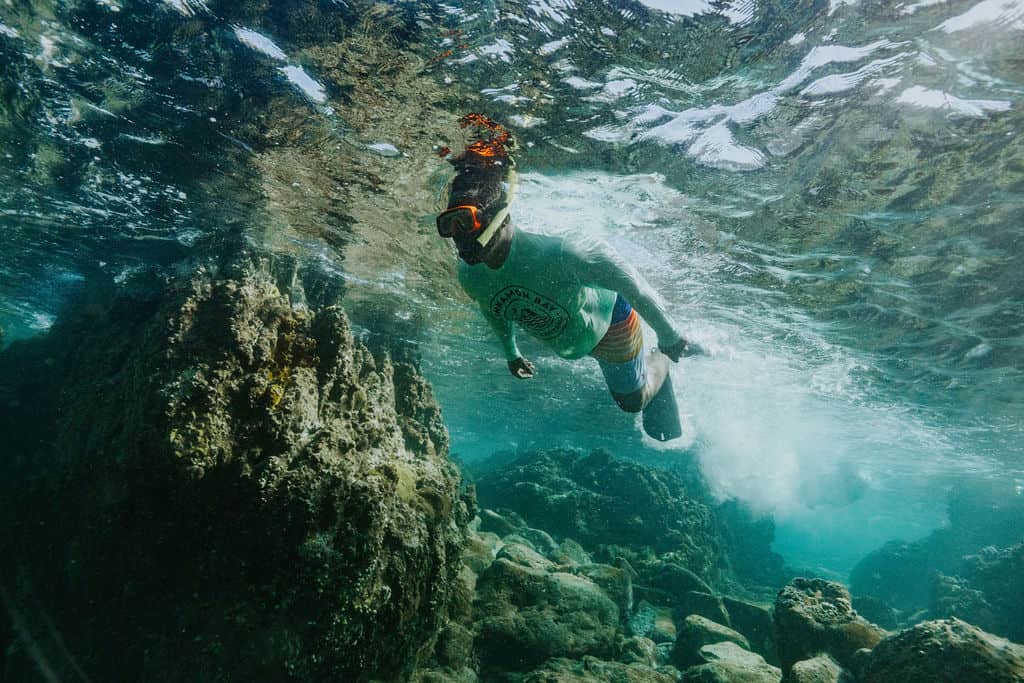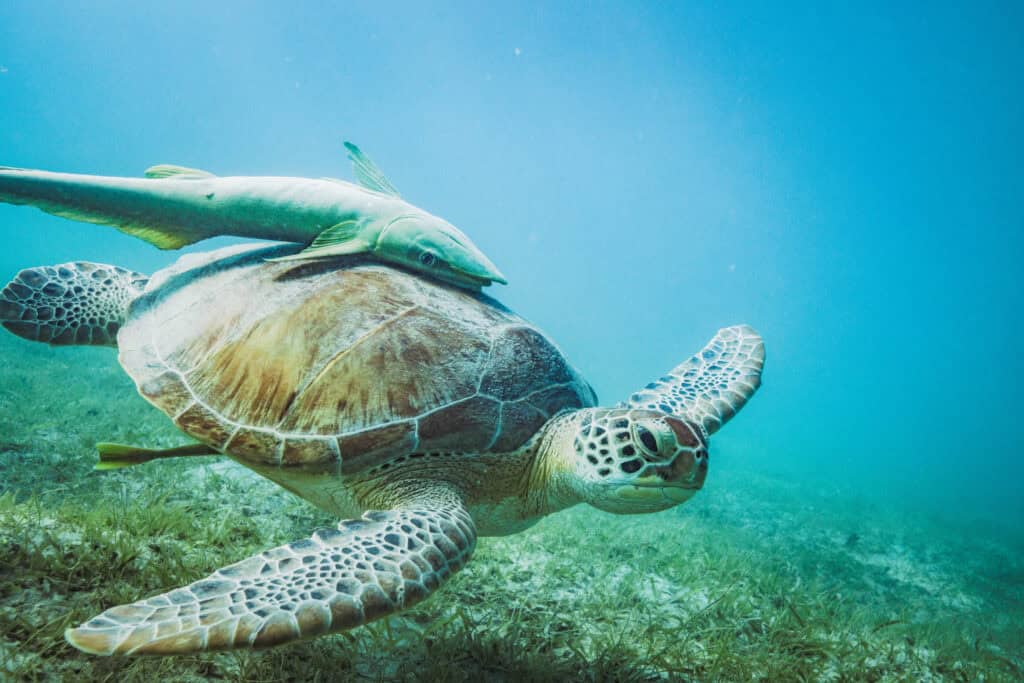
Explore the U.S. Virgin Islands’ Coral Reefs
The turquoise waters surrounding the U.S. Virgin Islands harbor a complex system of coral reefs, making the region one of the top diving and snorkeling destinations in the world. Often called the rainforests of the sea, coral reefs provide colorful homes for hundreds of marine animal and plant species. We’ve rounded up some of the coolest coral reefs you’ll want to explore in the USVI. Get ready to dive into this dazzling underwater world!
St. Croix Coral Reefs

Snorkeling at Buck Island Reef National Monument
Buck Island Reef National Monument
Snorkel or scuba dive along the dazzling coral reef at Buck Island Reef National Monument, a federally protected island off the northeast coast of St. Croix. The reef, which stretches around two-thirds of the island, is home to over 250 fish species and other marine life. Because it’s a National Monument, visitors must book a half- or full-day trip with an approved tour operator to see the island. Boats depart from Tamarind Reef’s Green Cay Marina or the St. Croix Yacht Club in Christiansted Harbor. It takes about one hour to reach the protected island. Half-day tours last between 3–4 hours and include a stop at Turtle Beach and a snorkeling session on the dazzling elkhorn coral barrier reef. Full-day tours take between 6–8 hours and include lunch, snorkeling and time to hike the island or relax on the pristine beach. Popular charters include Buck Island Charters and Caribbean Sea Adventures. Even beginners can easily snorkel the island’s coral grottoes via an underwater trail marked with plaques to help identify the fish living here.
Cane Bay Wall
Rated as one of the top snorkeling sites in the Caribbean, Cane Bay Wall is about 100 yards from shore in Cane Bay. Dramatically dropping from 40 to over 13,200 feet, Cane Bay Wall teems with reef sharks, stingrays, sea turtles, barracuda, parrotfish, angelfish and trumpetfish. Between March and April, you may be lucky enough to spot or hear humpback whales as they migrate along the island in the Puerto Rico Trench (the deepest part of the Atlantic Ocean). On rare occasions, you might actually encounter a whale shark!
Butler Bay
Discover three shipwrecks in Butler Bay: Suffolk Main trawler, the Northwind tugboat and a massive oil barge called the Virgin Islander. Encrusted with colorful coral and sponges, these former ships now house reef fish, making Butler Bay one of the most popular dive sites in St. Croix. The shipwrecks are best accessed by boat, as it takes about 20 minutes to swim to the site, often in strong currents. You’ll also need to be a strong swimmer to snorkel in Butler Bay. The deepest shipwreck is the Virgin Islander, which rests 80 feet below the surface.
St. John Coral Reefs

Snorkeling around underwater coral reefs in Cinnamon Bay in St. John
Trunk Bay Underwater Snorkel Trail
Over 40% of Virgin Islands National Park is underwater. Scuba divers and snorkelers can set off on a trek along the world’s first marked underwater trail, the 400-foot-long Trunk Bay Underwater Snorkel Trail just off the shore in picturesque Trunk Bay. The easy-to-access trail is marked with underwater plaques that direct you on where to snorkel and include fun facts about the sea turtles, eagle rays, parrotfish, barracuda and other fascinating marine creatures that live in the beautiful bay.
Waterlemon Cay
Dive into the waters surrounding Waterlemon Cay in Leinster Bay and snorkel among blue tangs, bluehead wrasses, conch, sea turtles, starfish and parrotfish. A half-mile-long trail leads from Waterlemon Beach to Leinster Point. Then, it’s about a 10-minute swim to the cay. Because strong currents sometimes surround the cay, this excursion is best-suited for more experienced snorkelers and confident swimmers.
Salomon/Honeymoon Bays
Access Salomon/Honeymoon Bays, two beautiful white-sand beaches, via a short hike on Lind Point Trail. The trail begins at the Visitor Center parking lot at the Virgin Islands National Park sign off North Shore Road. Dive in and snorkel the narrow reef that follows the shoreline toward Caneel Bay to see the brain, lettuce leaf, elkhorn and pillar coral colonies that shelter an array of colorful fish.
Cinnamon Bay
Dive into 3,000 years of human history on the island of St. John. Snorkel Cinnamon Bay to see the underwater fish holding pen (likely made by the Taino indigenous peoples or their ancestors), a submerged historic village and a sunken plane from the 1940s. Get tips on where to find these treasures at the Cinnamon Bay Heritage Center & Archaeology Lab. After your dive, relax on the gently sloping, snow-white beach or rent a kayak from the on-site watersports facility and paddle the bay.
St. Thomas Coral Reefs

A fish and a sea turtle underwater in USVI
Joe’s Jam
Joe’s Jam is known locally as the Coral Bowl, due to its bowl-shaped slope that starts at 30 feet and descends to 80 feet at its bottom. The bowl is covered in coral, and schooling fish swim along its varied levels. As you snorkel the magnificent bowl, keep your eyes peeled for parrotfish, pufferfish, lobsters, nurse sharks and eels. Southern stingrays are often spotted here — they can measure up to 6.5 feet from wingtip to wingtip.
Spratt Point
Spratt Point is a scuba-diving spot in St. Thomas with shallow waters and large, intricate coral formations, making it an excellent spot for first-time snorkelers and scuba divers. Crustaceans and small fish hide from predators in the many sunlit swim-throughs dotting this brilliant seascape of miniature underwater valleys and ridges.
Discover More Things to Do in USVI
Explore these stunning snorkeling spots.
Discover more beaches in USVI.
Spend a day exploring Water Island.
